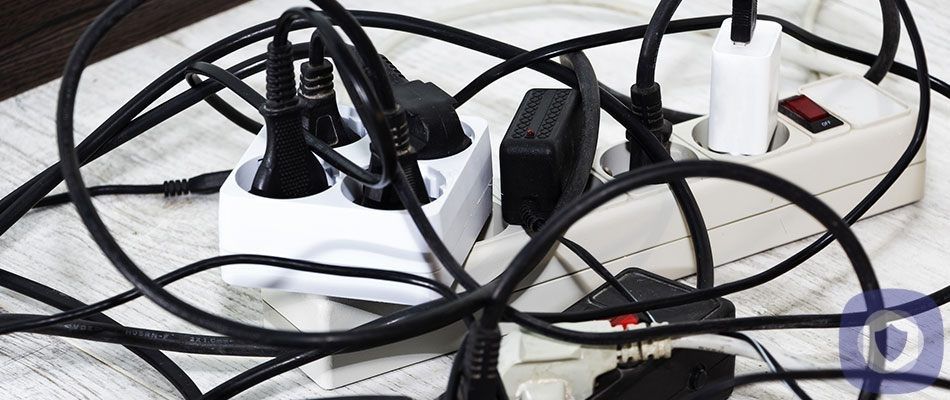Most of us couldn’t live without electricity, nor would we really want to. Electricity is what keeps the lights on and the food in the fridge cold. But living in a house powered by electricity also means electrical hazards are all around you.
As much as 51,000 electrical home structure fires occur each year, according to data from the non-profit Electrical Safety Foundation International (ESFI), and they cause more than $1.3 billion in property damage annually.
Before you panic and run to the breaker box to shut it all off, you should know that electrical hazards can be easily fixed—if you know what to look for. So sit tight, and let’s take a look at the some of the most common electrical hazards in homes, so you know what to do to ensure your home is as safe as possible.
Improper extension cord use
They’re handy, but extension cords cause an estimated 3,300 structure fires a year, according to ESFI. The best ways to ward off a problem:
- Don’t plug extension cords into one another.
- Inspect cords for damage before use.
- Never run cords through walls or use them in place of professionally installed wiring.
- Don’t allow the cords to rest in water.
Overloaded outlets
Extension cords aren’t the only way homeowners try to extend the usage of their outlets. If you’ve added power strips or adapters that are loaded down with multiple appliances, you’re increasing the risk of fire. That’s because each outlet is only rated to supply a certain amount of power. You can check with your electrician to find out more about your home’s electrical load. Don’t assume that you’re good using up each available spot in a power strip just because they’re there — check with a professional to see how much electrical load each of your outlets can handle and write the amounts down in a notepad so that you will always have that information.
Outlets too close to water or water near appliances or wires
These are technically two separate hazards, but the general rule is the same — water and electricity do not mix and can cause electric shock. To prevent this from happening, outlets should be installed as far from water as possible.
Look for ground fault circuit interrupter (GFCI) outlets. Designed with “test” and “reset” buttons, these are specifically made for installation in bathrooms, kitchens in areas where water is used, to prevent injury in case water and electric meet.
It’s also wise to keep an eye out for leaking water, lest it interact with your electrical appliances or your electric wiring and create a disaster. If you have leaking pipes, a leaky roof or standing water in a basement, get it fixed ASAP to avoid a short.
Outdated wiring or Faulty wiring
Two potential hazards that both revolve around the same thing — electrical wiring. Just like our appliances, wiring breaks down over time. If you’ve got old wires in your home, it might be time for an upgrade to prevent that breakdown causing a fire. The signs that it’s time for an update are similar to the signs that newer wiring is faulty and needs to be fixed:
- Difficulty drawing enough power to feed all of your needs.
- A burning smell that seems to come from the walls or outlets.
- Smoke coming from your outlets.
- Warm spots in the wall.
- Obvious fraying in exposed wires.
- Noisy electric, such as humming.
Appliances that often trip your circuits
A tripped circuit breaker is usually a one-time annoyance, but if it’s happening again and again, it’s time to get to the root of the problem. Is there an appliance you turn on right before it trips? You’ll want to look for damaged wires and consider calling the repairman. If you can’t easily identify the issue and your circuit breaker continues to get tripped when you turn on a certain appliance (or combination of appliances), call your electrician.
The wrong light bulbs
The numbers on the light bulbs that you pick up at the hardware store aren’t just for show. Lamps and other lighting fixtures have specific wattage ratings, and you’ll need to use bulbs that are at or below that number to prevent fire.
Improperly protected outlets
As much as 5,500 people are sent to hospital emergency departments every year due to injuries involving outlets, many of them kids. If you’ve got kids in the home, ward off the danger with tamper-proof outlet covers to keep the curious safe.
Electricity makes our lives easier every day, but it’s powerful and needs to be treated with respect. In addition to making some upgrades around the house, you may consider installing smart outlets that can be turned off from an app on your phone or contracting with an alarm company that can monitor for fire and smoke in the house.
This article has been reviewed and approved by Officer Banta.

Officer Banta is the official SecurityNerd home security and safety expert. A member of the Biloxi Police Department for over 24 years, Officer Banta reviews all articles before lending his stamp of approval. Click here for more information on Officer Banta and the rest of our team.

